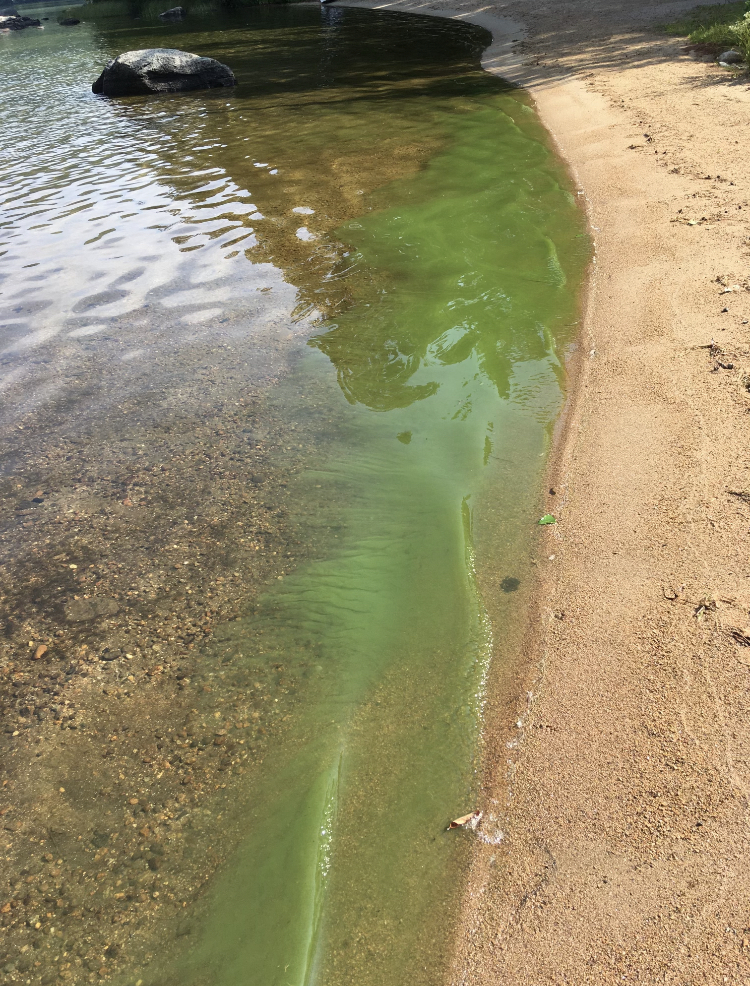By PAULA TRACY, InDepthNH.org
CONCORD – It is not even technically summer yet, but it is starting out as a bad season for cyanobacteria with the state’s earliest warnings ever on record and four lakes already on lists this week.
The water bodies with current advisories or alerts are Lake Monomonac in Rindge, Pawtuckaway Lake in Nottingham, Great Pond in Kingston and Partridge Lake in Littleton.
“We’re very concerned this is going to be a bad year for cyanobacteria blooms. We had a mild winter with little ice cover, meaning with the relatively warmer water there was an earlier start to the growing season for everything in the lake, and especially cyanobacteria,” said Andrea LaMoreaux, president and policy advocate for NH LAKES.
Also known as “blue green algae,” cyanobacteria is naturally occurring but in high concentrations can lead to scummy blooms which are toxic to humans and animals. Humans can get skin irritations, numbness, vomiting, diarrhea and damage to the kidneys and liver from exposure and in some cases, dogs have died of suspected cyanobacteria exposure here.
On May 15, a cyanobacteria warning was issued for Arlington Mill Reservoir in Salem, which is a backup drinking water supply and a shallow waterbody, said LaMoreaux.
“This is the earliest-ever public health advisory issued for cyanobacteria. And, since then, we’ve had a handful of public health advisories issued by the New Hampshire Department of Environmental Service, urging people to stay out of the water, and to keep their kids and pets out, too, for fear of becoming seriously ill,” she added.
The number of cyanobacteria reports have been increasing in recent years in the state and the legislature just passed a bill that creates a study commission in Senate Bill 543. It failed to pass two bills related to funding but there are programs which have been approved by the state’s Executive Council to distribute funds through the Department of Environmental Services.
“It’s going to be very important for everyone this summer to do their own risk analysis before going into the water,” said LaMoreaux. “There are two steps to a risk-assessment. First visually evaluate the water prior to recreating, looking for any discoloration or unusual growth, she said.
The state has a website listed at the bottom of the story where people can send photos of what they believe may be a bloom.
Second, LaMoreaux said, check DES’ resources to stay informed about active blooms across the state. DES advises people “When in doubt, stay out!”
Residents near water can minimize their impact by avoiding the use of fertilizers and fix any erosion issues that lead to soil and materials entering lakes, she said and urged boaters to act in a “lake-friendly way” including wake surfing as far away from shore as possible and in as deep of water as possible so that shoreline erosion and lake bottom disturbance doesn’t result in more phosphorus in the water to fuel plant, algal, and cyanobacteria growth.
A bill sponsored by state Sen. David Watters, D-Dover, was passed by both the House and Senate establishing the state Environmental Adaptation, Resilience, and Innovation Council.
It has not yet been signed into law by Gov. Chris Sununu.
The bill reads that “based on events in recent years, as well as future projections of environmental changes in New Hampshire, adaptation, resilience and innovation leadership at the state level can help residents, communities, businesses, institutions and state government itself become more resilient and ready to adapt to these changes.
“Environmental change will increasingly impact all communities in New Hampshire, as well as state assets and infrastructure, resulting in new challenges to public health, infrastructure, tourism, natural resources, water and wastewater services, revenue sources, and the economy.”
The council will help with comprehensive planning and identify financing to help battle the problem.
“Environmental change may disproportionately impact regions, populations, and natural resources in New Hampshire,” the bill states.
Cyanobacteria can stress existing services in health care, public health, education, transportation and other infrastructure.
The council will include representatives of various state agencies, the governor, the NH Municipal Association, the New Hampshire Association of Regional Planning Commissions, two members from environmental nonprofit organizations, an individual with expertise in environment or climate science, and a representative of the Business and Industry Association.
“The work of the council shall be guided by principles of seeking innovation in government operations, promoting effective approaches that build resilience against environmental changes to protect public health and foster business and workforce development, while protecting public investments and taxpayers, safety, and the responsible stewardship of the state’s natural resources,” the bill reads.
The council may decide on a need for better maps and data that indicate the areas of the state that may be most negatively impacted by environmental changes; review existing activities, identify gaps, and consider strategies to include environmental adaptation, resilience, and innovation planning in agency budget development; and consider the findings of the 2021 New Hampshire Climate Assessment Coastal Risks and Hazards Commission and the Coastal Adaptation Working Group, including needs for building coastal defenses and to protect infrastructure, state port facilities, water and wastewater infrastructure, and economic and cultural resources from storm surge and rising seas it reads.
It shall also make recommendations on potential funding to protect New Hampshire taxpayers from bearing the full burden of costs, and to explore innovative financing opportunities such as the creation of a state infrastructure financing authority.
The council shall report annually on December 1 on its activities and any recommendations for state agency actions, legislative proposals, and budgetary needs to the governor, the executive council, the president of the senate, and the speaker of the house of representatives.
To get more information about cyanobacteria and access the state map and tracker, visithttps://www.des.nh.gov/water/healthy-swimming/healthy-swimming-mapper





